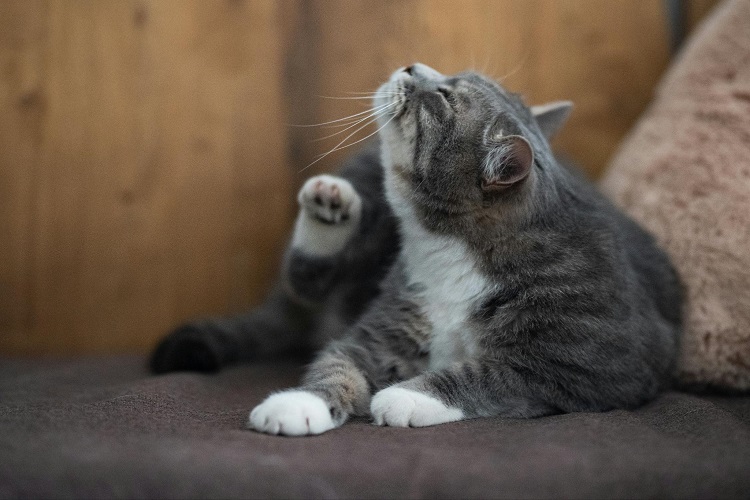Last Updated on March 2, 2024 by Georgie Smith
Cats, like any other creatures, can suffer from a variety of skin conditions that can cause them discomfort, pain, and even lead to more serious health issues if left untreated. From allergies to parasites, and everything in between, the skin of a cat is as much a canvas of their health as it is a barrier to the outside world.
The Common Culprits
One of the most frequent flyers in the world of feline dermatology is flea allergy dermatitis (FAD), affecting a whopping 40% of all skin disease cases in cats, according to a study published in the Journal of Veterinary Science. This condition is more than just an itch; it’s a hypersensitive reaction to flea bites, causing severe irritation and skin infections if not treated promptly.
Another contender is atopic dermatitis, a chronic skin disease linked to allergies, which affects around 10-15% of the feline population. This condition is akin to playing detective, as identifying the allergen can be a long and winding road, involving everything from food trials to environmental changes.
Not to be outdone, mites also throw their hat in the ring, with demodicosis and ear mites being particularly troublesome. While demodicosis is less common, seen in less than 5% of cats, ear mites are a prevalent issue, especially in kittens, with studies suggesting that up to 50% may be affected in some populations.
The Data Speaks Volumes
A survey conducted by the American Pet Products Association (APPA) revealed that cat owners spent an average of $200 annually on veterinary visits, with a significant portion of that going towards treating skin conditions. This statistic not only highlights the financial impact of these ailments but also underscores the importance of early detection and treatment.
Moreover, a comprehensive review in the Veterinary Dermatology journal found that over 80% of cats with untreated skin conditions develop secondary infections, complicating their treatment and recovery. This data points to the critical need for prompt veterinary care at the first sign of skin trouble.
Prevention and Care: A Stitch in Time
Preventing skin conditions in cats begins with regular, thorough check-ups with your vet, combined with a keen eye for the early signs of skin distress. Regular flea and parasite control is non-negotiable and can be a game-changer in preventing FAD and mite infestations.
Nutrition also plays a pivotal role in skin health. Omega-3 and Omega-6 fatty acids, found in high-quality cat foods, can bolster the skin’s defense mechanisms and promote healing. Moreover, regular grooming and skin checks can help catch any unusual signs early, from bald patches to excessive scratching.
A Tail of Recovery: Success Stories
Amidst the stats and data, it’s the stories of recovery that truly touch our hearts. Take, for instance, Luna, a tabby who battled with atopic dermatitis for months. Through a combination of dietary changes, environmental adjustments, and medical treatment, Luna went from a scratchy, miserable mess to a vibrant, playful cat, her coat as luscious as ever.
Then there’s Oliver, a sweet Ragdoll cat that had a severe case of flea allergy dermatitis. After a rigorous treatment plan including flea control, antibiotics for secondary infections, and lots of love and care, Oliver’s transformation was nothing short of miraculous. These stories underscore the resilience of cats and the difference that dedicated care can make.
Wrapping Up: The Feline Skin, A Mirror to Health
Cats, with their enigmatic personalities and complex needs, depend on us to decipher their health cues. Skin conditions, while common, don’t have to be a mainstay in their lives. With the right knowledge, care, and timely intervention, we can ensure our feline friends lead comfortable, itch-free lives.
This exploration into the skin conditions plaguing our furry companions serves as a reminder of the delicate balance of health and the importance of vigilance and care in pet ownership. Whether it’s through regular vet visits, preventive measures, or simply paying closer attention to their behavior and appearance, the well-being of our pets is, quite literally, in our hands.
Remember, every scratch isn’t just a scratch, and every itch isn’t just an itch. Behind these signs could be a story waiting to be told, a condition waiting to be treated. As we wrap up this foray into feline dermatology, let’s take a moment to appreciate the complexity and beauty of our cats, inside and out. After all, a healthy cat is a happy cat, and a happy cat makes for an even happier human.
So, there you have it, a dive into the world of feline skin conditions, filled with stats, stories, and a sprinkle of cat dander. Whether you’re a seasoned cat owner or new to the game, remember, knowledge is power, and in this case, it’s the power to make a difference in the lives of our furry family members.




![Best Guinea Pig Shampoo: Safe Shampoo For Guinea Pigs [2023] Guinea-Pig-Shampoo](https://morninghomestead.com/wp-content/uploads/2020/06/Guinea-Pig-Shampoo-150x150.jpg)
